Tony Hawk's Underground 2
Neversoft isn't about to start reinventing the wheel now, so instead it tries to find more exciting ways to turn it.
Order yours now from Simply Games.
You don't have to be a connoisseur of the Tony Hawk series to realise that it's not just about skateboarding any more. Even a cursory evaluation of the box artwork ought to tell you that. Over the years it's lost the big brash pictures of skateboards and the 'Pro Skater' title, and for this, the second Neversoft boarder to bear the Tony Hawk's Underground name, you actually have to pay attention to spot the lone skateboard in a montage of vans, cannons, bulls, modified lawnmowers and Jackass presenters.
And yet, for many, Tony Hawk's Underground 2 (or THUG 2) is probably the closest the series has been to its tight, twisty, tricked-out best since Pro Skater 3. The Story mode remains - it's no longer about climbing the ranks, but we'll get to that in a minute - but for THUG 2 Neversoft has decided to reinstate the two-minute timed runs of the originals in a separate Classic mode, which is more challenging and arguably more satisfying than the free-roaming, purely task-oriented Story alternative.
Six in six

Skating around is still just as enjoyable as it's ever been. Each of the new levels - of which there are plenty - is a multi-layered beast rife with perilous grind routes and quarter and half-pipes, and pulling off tricks in the air and segueing into rail-grinding whilst trying to stay upright and keep the wobbly balance meter in check remains addictive and - assuming you can bank the points - hugely satisfying.
Pick this up with no THPS or THUG experience behind you and, assuming you don't mind spending a few hours learning the ropes (and then remembering how to thread them all together in practice), you could be playing it from now until Christmas and beyond. There really is that much to do, see and learn if you want to really get the most out of it. If you don't believe us, leave the game on the title screen and wait for the rolling demos to kick in, then sit and back compare your own skills to those of the boarders plying their trade in the expert showcase. Even after skating the five previous Tony Hawk titles from beginning to end - and grinding every rail in-between - we still found ourselves cursing their abilities somewhat enviously.
Then again, we have already played five Tony Hawk titles, and this time we were really hoping for something new... or at the very least something else. THUG 2 doesn't really deliver that. (Indeed, it's quite telling that the one element we most enjoyed was the Classic mode.) What it does do though is refine what already worked to the point that it's the most exhaustive (and sometimes exhausting) series of challenges ever compiled in a skateboarding title. Just like the last one did, really.
Deeper Underground?
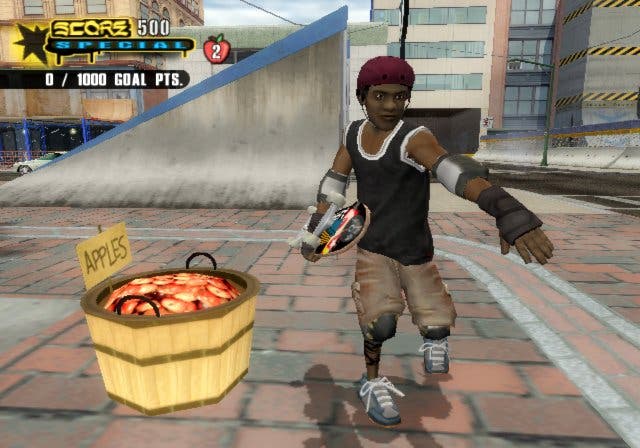
Very little of what worked in THUG has been taken out, and your skater's new tricks and abilities range from the prosaic and EA-style trademark-able bullet-points to sensible and much needed additions. Being able to spin-grind round small circular rails like tree stumps and rubbish bins is a curious if not hugely exciting change, tossing tomatoes and the like at pedestrians to complete certain goals is pretty basic to say the least, and the option to "Freak Out" by mashing the triangle button when you smash your face into the concrete mid-combo is unlikely to succeed our preferred method of venting frustration by chucking the pad at something breakable - even if it does earn you a handy bonus to start off your next combo attempt.
But on the other hand the addition of the "Sticker Slap" move, and a more integral system of mid-air flips and rolls, increases your options as you try and nail high-scoring combinations; a definite plus. Sticker Slapping lets you plant a "2" logo sticker on any wall if you skate towards it, jump and then hit jump again as you bang into it, but more importantly it also sends you off in the opposite direction with a fair amount of momentum, enabling you to go into a revert, manual or some other sort of trick to try and keep your combo going. The flips and rolls meanwhile can now be performed by simply holding circle and tugging a direction as you leap into the air off a quarter-pipe, and if you're anything like us it won't be long before you start working them into combos with great success.
The other significant gameplay change is the addition of "Focus", which is basically bullet time for skateboarders. When you want to make use of it, just press L3 (and, yes, that does mean you press it accidentally every so often) and it slowly saps your special meter while you move in slow motion - complete with a blurry, Max Payne-esque filter effect - and concentrate on nailing absurd tricks without getting your fingers tied up in knots. It certainly makes it a bit easier to get to those harder to reach spots when you can do some of the more technical high wire grinding in slow motion.
Not one for bedtime
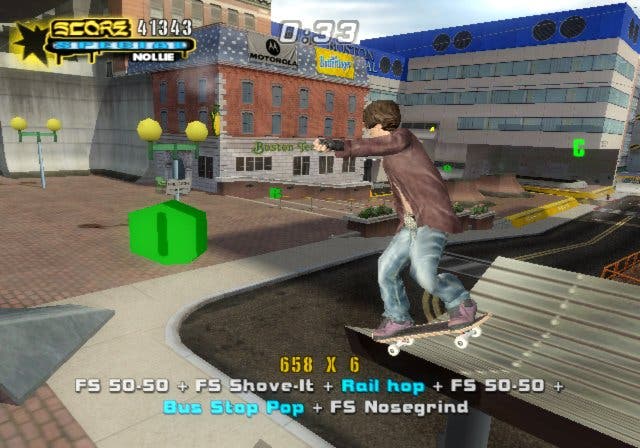
Those who played THUG will remember that the Story mode - a first for the series - put you in the role of a fledgling skater trying to make it to pro status, and it's an approach that worked very well. It was difficult to take seriously at times - particularly if the world of pro skating seems as surreal and alien to you as it does to us - but it gave the game a decent sense of structure.
THUG 2's offering dresses things up somewhat differently. You'll still find yourself skating around huge city-based locations trying to complete various tasks - spine transferring (so, jumping and landing) from a quarter-pipe to an opposing one on the other side of a statue, chucking things at pedestrians, grinding a particular series of benches or elevated rails, etc. - but this time you're doing it in the name of mayhem. The whole thing's turned into a feature-length episode of Jackass, complete with all the authentic names, faces and voices, as Tony Hawk and one of the mainstays of the MTV show, Bam Margera, organise for a pair of teams to set off on a "World Destruction Tour", taking in different skating locations and trying to out-do one another in the mischief stakes.
To mockingly note that "hilarity ensues" would be rather unfair. True, if you don't enjoy Jackass and the gratuitous slapstick style of humour that Margera specialises in then you're going to be skipping a lot of cut-scenes and ignoring a lot of in-game SMS-style text messages, but in truth even ardently anti-Jackass types will probably find that the game's gaudy sense of humour grows on them after a while.
Bullocks
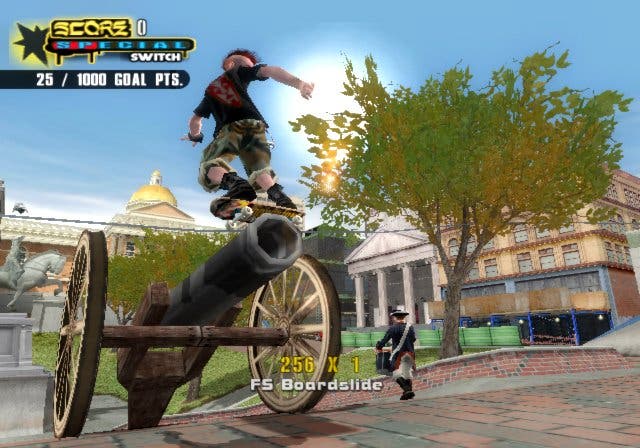
And, even if not, it doesn't really interfere with the way the game plays. Each level is packed with things to do, and a total of four characters to control - including a special guest (usually another Jackass presenter on a novelty ride, like a mechanical bull on wheels) and a special, level-specific character (like a matador in Barcelona) - and there are tasks specific to each and indeed some that involve all four.
There are still rather too many off-the-board bits (press L1 and R1 together and you can run around, climb things and spray-paint surfaces), and they're still clumsily implemented, but they aren't too much of a hassle to grin and bear. There's also a point in each level where you can trigger some sort of event that changes the layout subtly but importantly, much as there was in THUG, and this usually consists of opening up a new area with more grinds, more pipes, more tasks, and so on.
But, you know, we didn't like THUG's approach as much as we did the older Tony Hawk titles. The lack of a timer turned us into lazy skateboarders who would grind around needlessly for ages half-heartedly looking for the next NPC with a task to complete, and the odd timed challenge within each level didn't satisfy us the same way; we much preferred having to perform against the clock. THUG entertained us, but only to the extent that something like OutRun2 would do if you stripped out the timer. Easier going, but we'd miss the peaks of exultation.
Lightbulb!
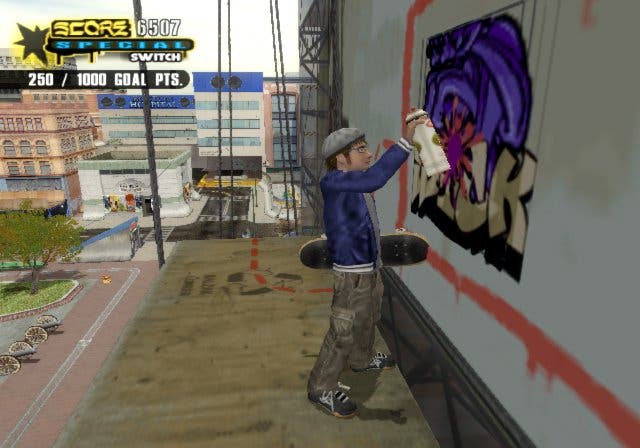
Classic Mode, then, is Neversoft's answer to that. "If you don't like the new approach, then fine, you can have the old one too." Seems fair to us, and pleasingly it hasn't led to a stifled or content-light pair of modes. Classic is rock hard at times compared to Story mode, which has some easier difficulty options and places a greater emphasis on exploration, and simply gives you a list of goals and two minutes to try and do as much as possible. You can do one, end your run and then restart the level and try another, but the real fun of it comes when you manage to complete a few in one go and build up a massive points total for the session. Think of it as a straightforward campaign style mode and a time trial rolled into one.
Best of all, Classic Mode doesn't just whack a timer on the bits you were tackling in Story mode, it features a different system of progression - "complete six goals to unlock the next level", rather than "get a certain amount of team points" - and a totally different range of tasks, and occasionally even levels. There are tighter, more technical courses along the lines of the ones in THPS 1-3 on offer here, and tasks like hitting a series of increasingly vast high scores, getting a certain amount of points in one combo, collecting the S-K-A-T-E letters and collecting C-O-M-B-O without touching ground are all on offer here, but not in Story mode. Particularly advanced Birdmen can even turn off some of the series' refinements like walking - or even manuals - to up the ante even further.
Perhaps this an attempt to appeal to as many people as possible, perhaps it's just a concession that the Story mode isn't the be all and end all, but either way it certainly helped THUG 2 keep this reviewer going a lot longer than THUG did, and between the two modes it seems safe to say that you'll rarely if ever be stuck for something else to go and do if you get bored of failing the same task repeatedly.
Create-A-Better-Online-Implementation

You aren't even limited to Story and Classic. The Create-A- tools let you create your own skater, spray-paint tag, level goals, tricks and skate parks - and the online options allow you to upload your own concoctions or download some of the vast number of fan-created efforts, and of course play against other skaters in various competitive modes.
Sadly though, in our experience the online implementation isn't as good as it used to be. The huge levels seem to introduce some slowdown we don't remember plaguing the last two particularly, and - although your mileage may vary - lag proved a bit of an issue for us during our online dabbling. Fortunately both of those issues seem less problematic in the smaller, more technical old school tracks, which is where we wanted to spend most of our time anyway, but we can see it being yet another pain in the network port for PS2 Online users.
And while we're on the subject of online options, it does seem utterly bizarre that Activision and Neversoft still haven't produced an Xbox Live-compatible version of Tony Hawk, despite this being the third annual update since the service launched. What's the problem, chaps? Live supports all of the things THUG 2 wants to do, and it's centralised and refined to the point that everybody knows exactly how to get it up and running - and it just works. Given that the US Xbox version of the game is the only one to support the higher resolution progressive scan modes, and the PAL Xbox version is smoother and better looking in any event, it's going to be quite a painful toss-up for quite a lot of Tony Hawk fans.
Baleful
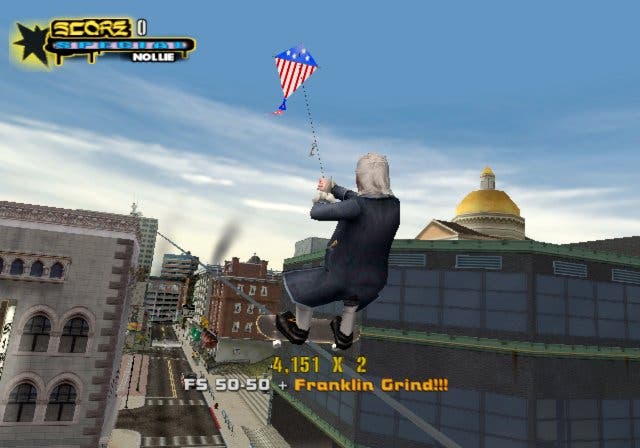
There are other problems too. Although technically it's a step beyond THUG - and that's a step rather than a leap - and looks brighter with much better and more believable character modelling and facial animation, it still seems hell-bent on letting itself down from time to time with clipping bugs, mild pop-up and other glitches, and some irritating control issues, like the way you seem to grab on to the backs of moving vehicles far more often than you actually want. Still, at least the cars and vans actually look vaguely believable in the game engine this time around.
To round things off on a musical note, it seems safe to say that the soundtrack is as marmite-y as ever. If you like the sorts of things that stereotypical skateboarders are supposedly into then you'll probably enjoy it, but this reviewer found himself picking out odd tracks and loathing the rest. Then again, those odd tracks were by Frank Sinatra, Joy Division and Johnny Cash, so you can't say Neversoft isn't trying to appeal to a broad demographic. And hey, you can isolate the music in the volume options and kill it off without losing the sound effects, so there's always the option of whacking a CD in the stereo nearby.
Perhaps the most critical thing we can say about THUG 2 though is that in its constant annual pursuit of new things, it seems to be much better at dragging people along with it than beckoning them in anew. The tutorial mode is necessarily extensive, which is fair enough, and it's sensibly divided into old school (existing) and new school (brand new) tricks and skills so that boarders new and old can get the appropriate level of education out of it, but at this stage there's arguably just too much to comprehend without struggling with a pretty steep learning curve for the first few hours with the manual firmly planted on your lap.
Turning pro
On the other hand, it's definitely worth the initial graft, just as the series always has been. It's been obvious since, ooh, Tony Hawk's Pro Skater 2 that Neversoft was going to have to start thinking outside the box - or at least off the board - to keep the series fresh and interesting until it makes the inevitable hop to the next generation of consoles, but even when the developer is at its clumsiest or most reliant on novelty, its output is still rarely less than excellent viewed in isolation.
As is generally the case when a new Tony Hawk rolls into town, this is now the best way to get into the series, and it's probably the most enjoyable Hawk we've played since Pro Skater 3. For returning fans, THUG 2's list of new features is a bit shorter than it has been in previous years, but then the additions arguably make a bigger impact, and the decision to reinstate Classic mode ought to bridge the gap for people who gave up when the series ditched the timer and starting picking up the deck.
In other words, there's probably enough here to satisfy fans whatever their inclination, but nobody should expect a quantum leap. Once again it's refinement over revolution.

